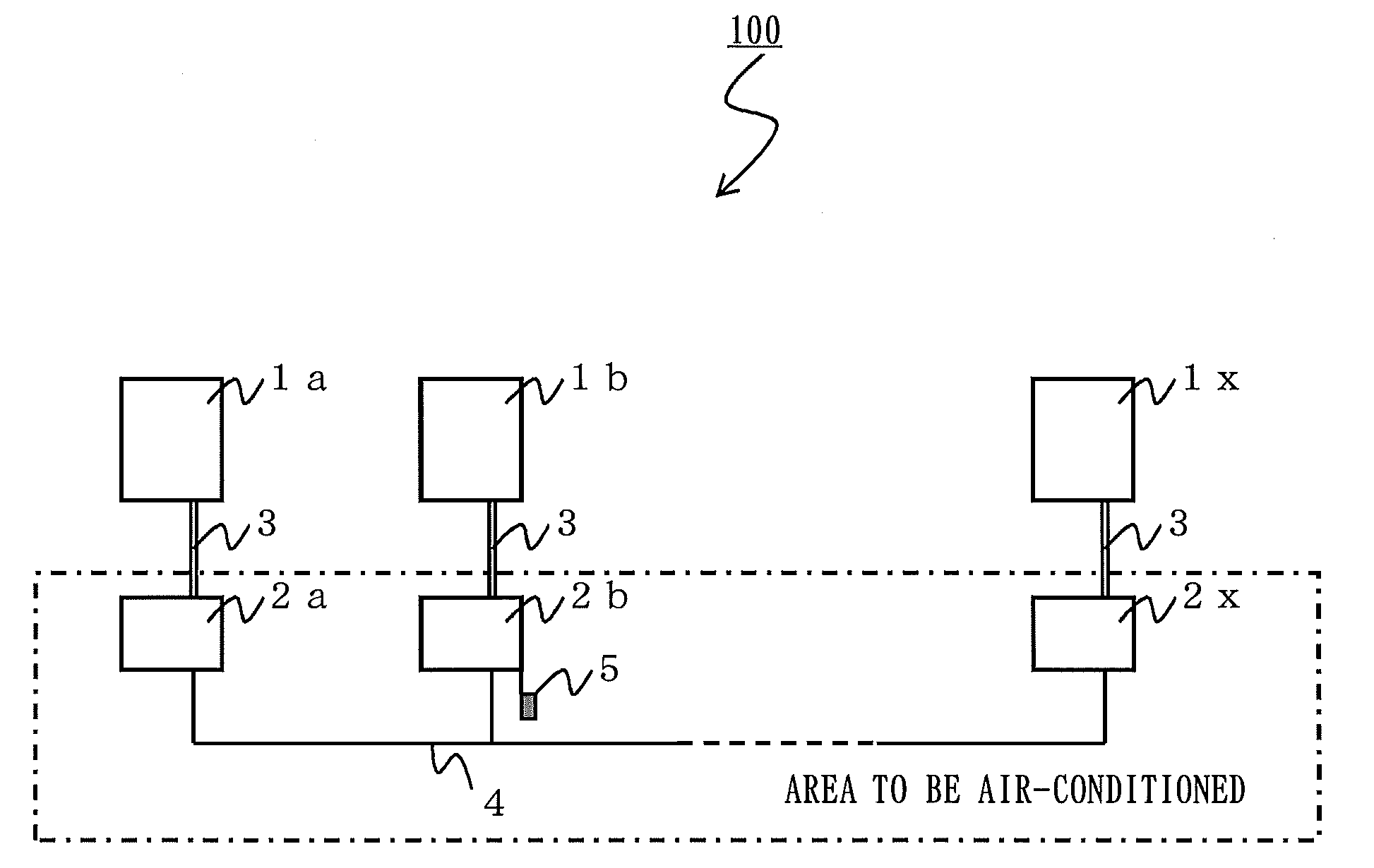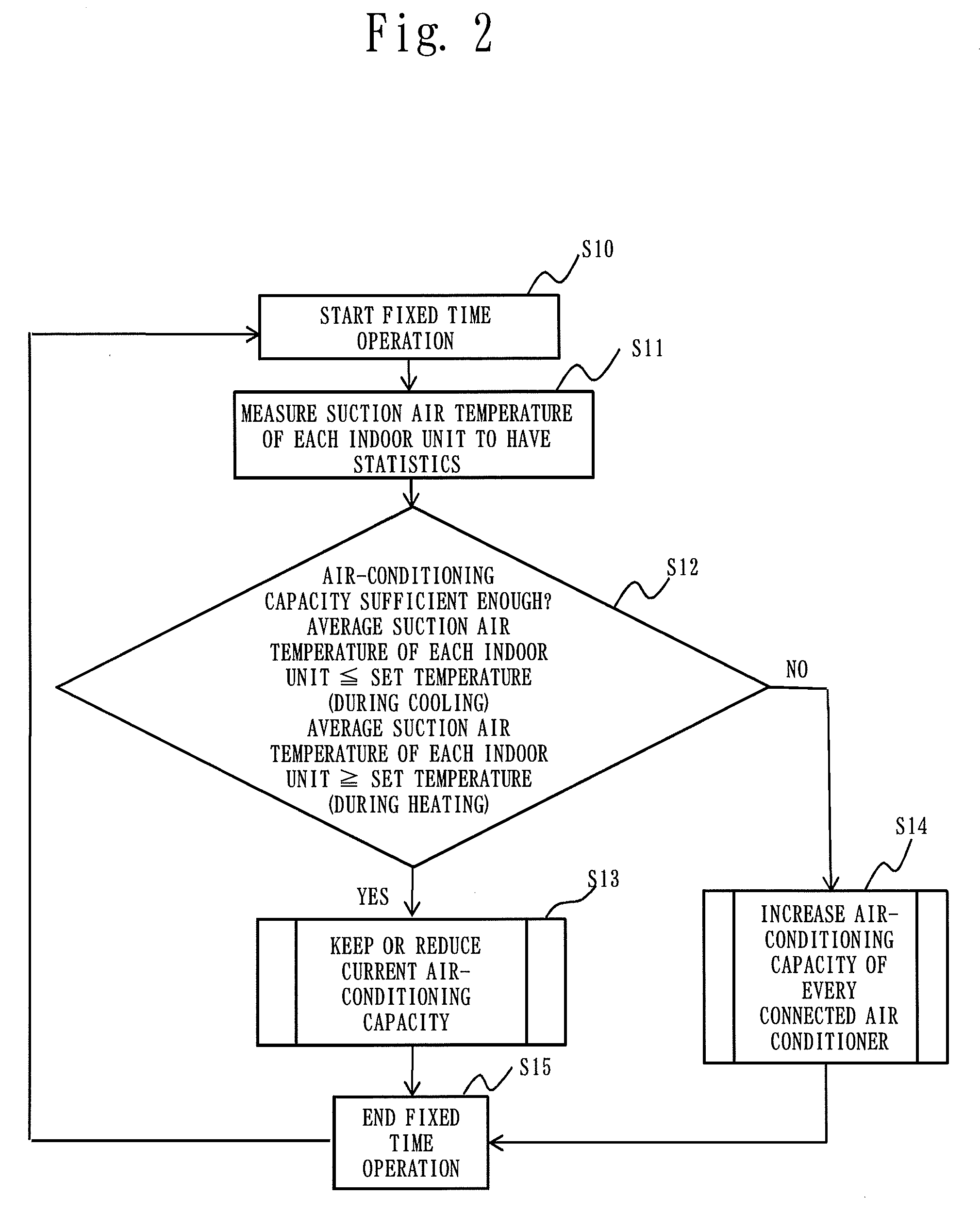Air-conditioning apparatus
a technology for air conditioners and air conditioners, applied in the direction of instruments, heating types, static/dynamic balance measurement, etc., can solve the problems of low efficiency, reduced overall efficiency of the group of air conditioners, and increased frost, so as to reduce the power consumption of air conditioners and level their air conditioning capacities. , the effect of no load variation
- Summary
- Abstract
- Description
- Claims
- Application Information
AI Technical Summary
Benefits of technology
Problems solved by technology
Method used
Image
Examples
embodiment 1
[0025]FIG. 1 and FIG. 2 illustrate a first embodiment. FIG. 1 shows a block diagram of an air-conditioning apparatus 100. FIG. 2 shows a flow chart illustrating a temperature adjustment control. FIG. 3 shows capacity, input and COP (Coefficient of Performance=capacity / input) indicating operating efficiency, to the frequency of an inverter driven compressor used in a general air conditioner.
[0026]As shown in FIG. 1, the air-conditioning apparatus 100 may include a plurality of air conditioners. More specifically, the air-conditioning apparatus 100 may include a plurality of outdoor units 1a, 1b, . . . and 1x, a plurality of indoor units 2a, 2b, . . . and 2x, pipes / wires 3 for connecting the outdoor units 1a, 1b, . . . and 1x and the indoor units 2a, 2b, . . . and 2x, respectively, connecting wires 4 for allowing the indoor units 2a, 2b, . . . and 2x to communicate with one another, and a remote control 5. The pipes of the pipes / wires 3 may be refrigerant pipes, and the wires may be p...
embodiment 2
[0047]The plurality of air conditioners of the air-conditioning apparatus 100 of FIG. 1 may be characterized as follows, during heating: The indoor units 2a, 2b, . . . and 2x communicating with the outdoor units 1a, 1b, . . . and 1x via the internal / external communication lines of the pipes / wires 3 and the connecting wire 4 are allowed to obtain statistics on the frosted states of the outdoor units 1a, 1b, . . . and 1x. More specifically, the frosted state of each outdoor unit 1a, 1b, . . . , 1x may be obtained by the temperatures of pipes and the operating time for heating of an outdoor heat exchanger installed in the outdoor unit, or the like.
[0048]FIG. 4 shows a flow chart illustrating a defrost control according to this embodiment. The defrost control is now described with reference to FIG. 4.
[0049]When a fixed time heating operation is started (S20), the temperature of the outdoor heat exchanger of each air conditioner is measured to have statistics (S21). The temperature of th...
embodiment 3
[0065]The plurality of air conditioners of the air-conditioning apparatus 100 of FIG. 1 may be characterized as follows during cooling: The indoor units 2a, 2b, . . . and 2x communicating with the outdoor units 1a, 1b, . . . and 1x via the internal / external communication lines of the pipes / wires 3 and the connecting wire 4 are allowed to obtain statistics on the temperatures of the indoor heat exchangers (i.e., evaporation temperatures) of the indoor units 2a, 2b, . . . and 2x.
[0066]If a person in a room (i.e., an area to be air-conditioned) issues an instruction to give priority to dehumidification by a remote control 5, then the air-conditioning capacities of several air conditioners are increased and their evaporation temperatures are reduced. The air-conditioning capacities of the rest of the air conditioners are reduced, or their operations are switched from cooling to blowing, in order to adjust increased overall air-conditioning capacity, thereby preventing an excessive redu...
PUM
 Login to View More
Login to View More Abstract
Description
Claims
Application Information
 Login to View More
Login to View More - R&D
- Intellectual Property
- Life Sciences
- Materials
- Tech Scout
- Unparalleled Data Quality
- Higher Quality Content
- 60% Fewer Hallucinations
Browse by: Latest US Patents, China's latest patents, Technical Efficacy Thesaurus, Application Domain, Technology Topic, Popular Technical Reports.
© 2025 PatSnap. All rights reserved.Legal|Privacy policy|Modern Slavery Act Transparency Statement|Sitemap|About US| Contact US: help@patsnap.com



